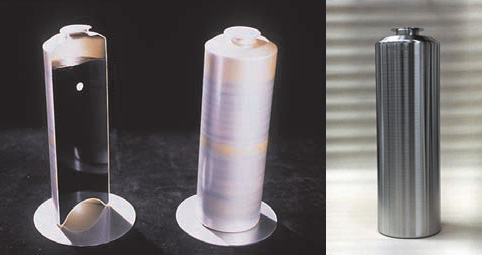Packages for trapping radioactivity…

Trap radioactivity in packages
At the La Hague plant, solutions of fission products and minor actinides are calcined at around 400 degrees C, then vitrified by mixing with glass frit in an oven at around 1100 degrees C. The molten glass is poured into a cylindrical container (right) made from special steel. A lid is welded on to the container body. The cutaway model on the left shows the interior of a standard vitrified waste container. The mass of the glass is approximately 400 kg, and the mass of the radioactive products within it, around 11 kg.
© AREVA/ANDRA
Conditioning means containing the radioactivity and immobilising the radioactive atoms. The atoms have to be immobilised until they are no longer radioactive, or if that is not possible, until they have nearly reached that state. The capacity of the package to withstand damage from the radiation naturally depends on the activity of the material being processed.
The activity is greatest with spent fuel from nuclear power plants. When a reactor is in operation, the radioactivity is contained by the zirconium cladding, which consists of tubes that hold the fuel pellets. This cladding must be the primary containment barrier once the fuel has been unloaded. To reinforce the barrier, the irradiated fuel assemblies are placed in special containers known as canisters or casks.
If the irradiated fuel is reprocessed, it is the residue of highly radioactive material considered as waste that is contained. This radioactive residue is incorporated into a material known as the ‘matrix’, selected for its ability to withstand damage caused by radiation. The matrix must be able to incorporate a sufficient quantity of radioactive atoms. It must be able to resist being dissolved in water for thousands of years.
Special types of glass are currently used as the matrices for high activity waste at the La Hague plant. Glass is an amorphous material with an extremely flexible structure that absorbs the effect of the radiation. Glass is a very effective conditioning matrix for all the different types of fission products.
As part of research into waste, a number of ceramics have been developed that are more expensive but even more durable. These ceramics – mineral compounds processed at a very high temperature – have the property of being able to incorporate into their crystal structure atoms with good chemical compatibility. Long-lived radioactive atoms could therefore be completely immobilised in these structures, as bespoke matrices.
Protection could thus be offered for very long periods of time against elements such as iodine-129 and caesium-135, which are naturally fairly mobile and difficult to destroy by transmutation.
Other articles on the subject « Waste strategies »
Slow disappearances
Trapping radioactivity until it disappears A scenario for the long-term future of the waste It wi[...]
Oklo : a natural reactor
Nature at work over the last two billion years It was noticed by chance in the 1970s that a urani[...]
Diluting radioactivity
A practice for elements with low levels of toxicity Management of radioactive waste generally foc[...]
Putting it out of reach
Containment and burial when it is not enough to wait Letting time do its work is not sufficient o[...]
Temporary storages …
Storing: a useful but temporary solution Storing means tidying an object away with the intention [...]
Deep geological disposal
Ground-level and deep disposal: a definitive solution Deep disposal of the most radioactive waste[...]
Separating and sorting
Sorting radioactive waste has advantages As with household waste, sorting can prove really useful[...]
Destroy (transmutation)
Transforming radioactive nuclei to make them less troublesome… The incineration of househol[...]
What to transmute?
Transmuting long-lived actinides and fission products Long-lived elements: actinides and fission [...]
Transmuting actinides
Attractive in principle, difficult in practice Destroying actinides using fission reactions is at[...]